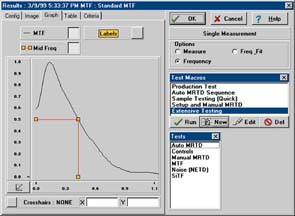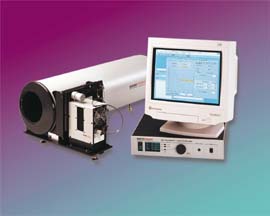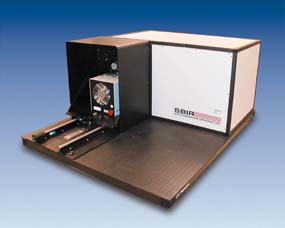|
May 1999 |
A Turnkey |
||||||
|
|
|
|
Infrared
imaging systems, the see-in-the-dark marvels that performed so well
in Desert Storm, have historically been produced in small quantities,
primarily for military customers. But new low-cost technologies and
the economics of large-scale production have made these devices available
to commercial customers, for tasks ranging from the mundane, such
as troubleshooting steam pipes, to the exotic, such as night vision
for cars. Along with these changes, a new challenge has emerged: the
need for quick, repeatable, accurate, low-cost testing of the IR imager.
In the low-volume high-dollar military market, it was practical to have experienced and knowledgeable personnel, typically part of the engineering team, involved in the testing of the production systems. For small quantities, testing could be done manually: The operator would position the correct target in front of the blackbody, set the blackbody temperature, wait for the system to settle, take a data point by observation of unit under test (UUT) output, and repeat the process for the next data point. This is a slow, tedious, error-prone process that relies on trained and experienced observers to accurately interpret the imager output. For larger production quantities, automated testing needed to be developed. In addition to faster testing, an automated test system could help eliminate operator error both in the operation of the equipment and in the recording and reduction of test data. Bob Nicklin, senior systems engineer for industrial automotive IR products at Raytheon TI Systems, in Dallas, TX, has implemented automated test systems for several IR imaging programs at Raytheon. "Repeatability, accuracy, quality, and operator independence are all as much a concern for us as speed," Nicklin said. "Manual testing imposes a boring, repetitive task on an operator, and we can't get the consistent overall product quality that we're committed to delivering. The time saved is an obvious tangible benefit, but these less tangible effects are important." Obstacles Posed by Traditional Methods The obstacle to automated testing, however, was the time and expense of developing the test system. The process looked something like this:
Several man-years could be expended on the development of such test equipment. The result, too, would be a specialized test system, suitable only for one type of imaging system. Since development time was limited and the target audience small, the user interface was typically rudimentary -- difficult to learn and use. To add a new test or modify an existing one, the software engineer would have to be tracked down and scheduled to rewrite some of his code. When a new imaging system needed testing, the process would start all over again.
Automated
Testing
An engineer familiar with using other Windows applications can learn how to use IRWindows in a few hours. A knowledge of programming is not needed. After learning IRWindows, the months-long task of creating an automated test is reduced to literally minutes. It is actually easier to specify a test in IRWindows than to perform the test manually. Additionally, uncertainty about the validity of the test results is no longer an issue.
Nicklin chose to buy IRWindows to test Raytheon's
new uncooled PalmIR camera. "A capital equipment purchase is so much
easier than putting together a test equipment development program,"
said Nicklin. "Sure, we understand the principles and could create
our own test system, but we had more important problems to worry about.
Our own hardware is where we need to spend our time." Success with
the PalmIR program led Nicklin to implement the same IRWindows test
system on several other Raytheon camera programs, most recently the
Driver's Vision Enhancement (DVE) system (see Figure 3), a
night-vision camera to be offered as an option in next year's Cadillac
DeVille. "We really need automation on DVE," says Nicklin. "We're
committed to deliveries of as many as 60 units per day to Cadillac.
But it makes sense even for a small program. With the time savings
and the improved overall product quality, the software is essentially
free."
Automated testing is the better way to test infrared imaging systems. It eliminates operator error, removes reliance on human perception, and generates repeatable and accurate test results. Automated testing is now practical even for the development lab, or the end user, or other applications that do not have the high volume of testing traditionally associated with automatic test systems.
|


